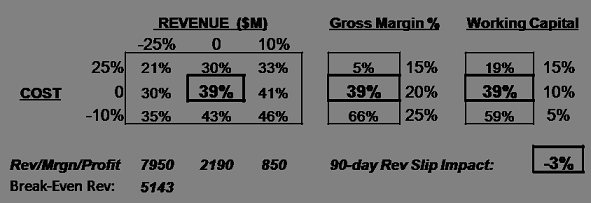Once you’ve quantified the risk surrounding your business decision (see my previous two posts on this topic) there comes the matter of presenting it in a manner that actually facilitates the decision making process, rather than bogging it down in irrelevant details. It’s not, of course, that executives are innumerate, but rather that everything needs context, context that is understood by the decision making audience. I have found that this is one case where a visual, graphic representation of the financials and the risks is not the best format. Yes, it’s important that the analysis accurately reflect confidence intervals and standard deviations, but getting the executive team focused on the primary risk factors affecting the decision are generally not aided by a one-tailed, color-coded distribution curve. Instead, I suggest framing the decision in terms of relative over and underruns with respect to numbers they are already familiar with.
In my typical presentation, shown below, I create a 3x3 IRR Risk Sensitivity Matrix. The IRR (internal rate of return) for the most-likely case (39% in this example) sits boldly in the center. Around it are the IRR figures for favorable and unfavorable revenue and cost combinations. These should be intuitive; in this example costs very seldom underran by more than 10% but could often be over by 25% or more, with the reverse true for revenue projections. This framing fell statistically between one and two standard deviations, so we felt certain we had at least 70% of the scenarios covered, with perhaps up to 90%. The relevant gross $$$ numbers were shown directly below the matrix (more context), especially the all important Break-Even revenue amount. Additional analysis off to the right shows the impact of changing margins (i.e. price pressure) and use of working capital for inventory and A/R. Lastly, the impact of a 90-day slip in delivery, and therefore revenue/cash streams, was computed.
The presentation for the evaluation is just 5 slides:
1) A description of the project, it’s IRR, when PBT and cash turn positive, and the key RISK factor
2) The IRR Risk Sensitivity Matrix
3) A list of risk mitigation items and actions
4) Summary five-year financials (Rev, Costs, Margins, Staffing, Capital, PBT, Payback, IRR, Cash)
5) A graphic representation of those same financials
Using the above matrix as the example, you will notice that the financial return on the project can withstand a worst case scenario of a 25% cost overrun AND a 25% revenue shortfall, it would be mildly impacted by high working capital requirements, but it is extremely sensitive to price and maintaining its margin. The discussion would therefore focus on the risk mitigation plans regarding price and margin on slide 3, with the project sponsor being drilled mercilessly regarding each issue and contingency. Slides 4 and 5 were in the distributed review package for reference but were seldom presented or discussed.
Not only did this approach lead to better business decisions, it paved the way for a true partnership between Finance and the business units. Whereas in the past when all you had was a single IRR number, Finance typically played the role of Dr. No; if it didn’t meet the hurdle rate it was a no-go, but that was the extent of the financial involvement. Since no one understood the profit and risk drivers, there was no ability other than trial and error to make the project workable. Now, finance could work with a business manager to modify the business plan to bring it in line with requirements. Each project has a life of its own, its own unique set of drivers. For one project, improvement might mean using a lower cost distribution channel, for another it might mean developing the product or entering the market in phases, for another it might mean better pricing or payment terms from a supplier. Dr. No became Dr. How Can We Make This Work.
Perhaps most importantly, though, it helped turn technical wizards with little financial knowledge into true business managers. It served as an education platform for brilliant engineers with terrific ideas but no plans to ever earn their MBA, allowing them to understand what it would take to make their idea a commercial success, from sourcing to design to migration to implementation to service, issues typically outside their technical experience but vital to bringing their idea to market.


3 Comments
Pingback: Your Risks are in your Assumptions (where they should be) - Value Alley
Pingback: Agile risk management – What might that look like? - Value Alley
Pingback: Agile strategy, revisited - Value Alley